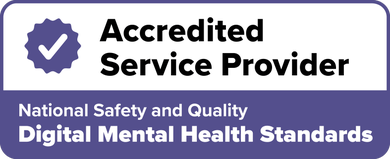Why anxiety causes headaches (and how to ease the pain)
In a Nutshell
Anxiety can contribute to headaches by increasing muscle tension, disrupting sleep, and affecting brain chemicals involved in pain regulation.
Headaches linked to anxiety often present alongside other physical symptoms, such as nausea, chest tightness, or restlessness, and may respond to a combination of psychological, medical, and lifestyle approaches.
Support from a mental health professional, including therapies like CBT or somatic therapy, can reduce both anxiety and the frequency of headaches over time.
Anxiety isn't just in your mind. It can affect your breathing, your posture, digestion, and even your sleep, all of which contribute to pain and fatigue.
Headaches are one of the most common physical symptoms linked to anxiety. Many people experience tightness across the forehead, pressure behind the eyes, or a dull ache that lingers long after stress has passed.
If this is something you’re experiencing, you’ve landed on the right place. We’ll discuss anxiety headaches and how to treat them in the sections that follow.
Does anxiety cause headaches?
Yes, anxiety can cause headaches. It does this by triggering physiological responses such as muscle tension, disrupted sleep, and changes in brain chemistry, all of which can increase your pain sensitivity.
However, not all headaches are caused by anxiety. Understanding how anxiety-related headaches differ from other types can help identify the best way to manage them.
Anxiety-related headaches vs other types
Headaches can stem from many causes, such as dehydration, muscle tension, eye strain, caffeine withdrawal, or sinus congestion. Anxiety is also a frequent contributor and can heighten the impact of these other triggers, making headaches more intense or persistent.
Tension-type headaches are the most closely linked to anxiety. They usually feel like a steady, dull pressure or a tightening band around the head, often accompanied by stiffness in the neck or shoulders.
Migraines involve throbbing or pulsating pain, often on one side of the head. They may also cause nausea, light sensitivity, or sound sensitivity. Anxiety doesn't cause migraines directly, but it can increase their frequency and severity.
Cluster headaches produce sudden, severe pain around one eye and occur in cycles or "clusters" over several weeks. They're less common but can be extremely debilitating.
Secondary headaches are caused by another medical issue, such as a sinus infection, vision strain, or high blood pressure. If your headache pattern changes or comes with unusual symptoms, it’s important to speak with your GP.
Anxiety-related headaches often occur alongside other signs of stress, such as sleep disruption, jaw tension, restlessness, or racing thoughts.
In a clinical study of headache patients, 37 % of those patients had generalised anxiety disorder (GAD), which was significantly higher than in comparison groups, indicating a strong co‑occurrence of anxiety in those with chronic headache conditions.
How anxiety triggers headaches
Several processes in the body link anxiety and headache:
Muscle tension: Ongoing stress tightens muscles in the neck, shoulders, and scalp, which can restrict blood flow and create pressure pain.
Chemical changes: Fluctuations in serotonin and other neurotransmitters that regulate mood and pain sensitivity can make headaches more likely.
Fight or flight activation: Anxiety activates the body's stress response. This increases heart rate and blood pressure, heightening pain perception.
Lifestyle habits: When anxiety affects appetite, hydration, or sleep, these disruptions can further increase headache risk.
Shared pathways – Anxiety, depression, and migraine often overlap through shared neurological mechanisms. A study published on BMC Neurology found that people who experience both anxiety and depression have significantly higher migraine frequency than those without these conditions.
How to soothe and treat anxiety headaches
The most effective treatment approach combines immediate relief strategies with long-term anxiety management.
Short-term ways to relieve pain
Stretch and reset your posture: Simple movements that loosen the neck and shoulders can reduce muscle strain. Small posture adjustments, especially during a long period of desk work, can prevent tension from building up.
Apply gentle heat: A warm compress across the shoulders or the back of the neck helps relax tight muscles and improve blood flow.
Stay hydrated and eat regularly: Skipped meals and dehydration often worsen headaches. Keep water nearby and aim for balanced meals throughout the day.
Breathe slowly and deeply: Controlled breathing steadies the nervous system. Try breathing in for four seconds, holding briefly, and exhaling for six.
Prioritise quality sleep: A consistent sleep schedule and good sleep hygiene can support your body's natural recovery systems and reduce tension that can build into headaches. Try to go to bed and wake up at the same time each day, limit screen time before sleep, and create a calm, dark sleep environment.
Use over-the-counter medication thoughtfully: Occasional use of ibuprofen, paracetamol, or naproxen is safe for most adults, but using them too frequently isn’t advisable. If your headaches have become so bad that you seek OTC medication regularly, it’s best to see a doctor as soon as possible.
Psychological and behavioural strategies
Cognitive behavioural therapy (CBT): CBT helps identify patterns of thinking and behaviour that sustain anxiety. For people with recurring headaches, CBT can help support both pain reduction and how you cope with anxiety and the situations that make you anxious.
Somatic therapy: Somatic approaches focus on physical awareness and the release of stored tension. By noticing sensations, breathing patterns, and posture, you can calm your body's stress response and reduce muscle tightness linked to anxiety headaches.
Mindfulness practice: Short mindfulness sessions, even just a few minutes of quiet attention to breathing, can reduce stress hormones, lower muscle tension, and improve pain tolerance.
Biofeedback and relaxation training: These therapies use sensors to help individuals recognise early signs of muscle or nerve tension. Over time, they learn to consciously relax those areas before pain sets in.
Tracking your triggers: Keeping a simple log of sleep patterns, meals, stressors, and mood can highlight recurring links between anxiety spikes and headache onset. This makes prevention more targeted and practical.
Medical and professional care
Preventive medications: For people who experience headaches several days a week, doctors may prescribe low-dose antidepressants or specific migraine preventives. Some of these medications also support anxiety reduction.
Specialist care: Neurologists or pain specialists can assess complex cases and offer tailored treatments like nerve blocks or newer migraine therapies.
Counselling and psychological support: Working with a psychologist or an anxiety therapist can help you address the underlying anxiety that drives physical symptoms. While the cost of counselling varies, Australians can access subsidised sessions through a GP’s Mental Health Care Plan or low-cost digital options such as the MindSpot Clinic.
Finding balance again
Anxiety-related headaches don’t exist in isolation. They often appear alongside other physical symptoms like nausea, chest tightness, muscle tension, sleep disruption, or difficulty concentrating.
These are signs that your body's stress response is staying switched on for longer than it should. Left unaddressed, this ongoing strain can create a cycle where anxiety fuels pain, and pain reinforces anxiety.
Finding relief involves more than just treating the headache itself. It means paying attention to what’s happening in both your mind and body. Strengthening your sleep hygiene, building emotional resilience, and addressing ongoing stressors, like personal pressures or workplace conflicts, are key parts of recovery.
Get Help
Overcome your anxiety and book a free online consultation with one of our top rated therapists
Essential Reading about Anxiety
Free Mental Health Tests
Frequently Asked Questions
It usually feels like a tight, dull ache on both sides of the head, sometimes extending to the neck or jaw. The pain may build gradually during stressful situations or after long periods of concentration.
Yes. Anxiety often affects the digestive system, breathing, heart rate, and muscles. Common examples include nausea, chest tightness, trembling, and fatigue.
If headaches appear during stressful times and improve when you relax or sleep, anxiety is likely involved. A GP can confirm there is no other medical cause.
Research shows that therapy, especially CBT and somatic therapy, can help reduce both anxiety and associated physical symptoms. If cost is a concern, ask your GP about Medicare-subsidised sessions or explore community counselling options.
Relief can take a few weeks to a few months, depending on how long symptoms have been present and what coping strategies or treatments you use. Consistency is key, and combining professional care with everyday self-care habits gives the best results.
Anxiety Therapists Available Now
VIC
Psychologist
Hi! I'm a registered psychologist with a Master's of Psychology from ISN. I work with clients experiencing anxiety, depression, OCD, perfectionism, injury, grief and loss...More
QLD
Psychologist
If youre feeling overwhelmed, anxious, stuck in your head, or disconnected from yourself, youre not alone. Im Casey Barnard, a Psychologist and Health Coach who helps peo...More
NSW
Psychologist
Hi! I'm Katherine, a registered psychologist who provides client focused sessions with compassion and evidence-based care. I am passionate about creating a safe space for...More








